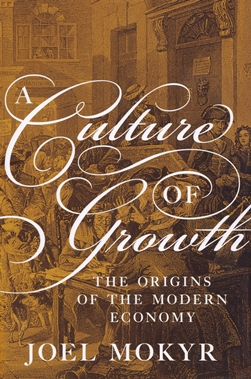 A Culture of Growth - The Origins of the Modern Economy
A Culture of Growth - The Origins of the Modern Economy
Cultural, scientific and economic historians love to mull over a central question in the development of the modern world order. Just why did the Industrial Revolution begin at the time and place it did, and so initiated the phenomenon known to their tribe as the 'Great Divergence' or 'Great Enrichment'? Suddenly, after millennia of economic stasis, Europe, and thereafter much of the world, became immeasurably richer than ever before.
Was it the growth of a Baconian science? Was it communications? Was it Europe's many fractious political units vying with one another? Was it a simple and novel faith in progress, and if so, where did that come from? And why had it not arisen before, notably in China - the famous 'Needham Question'?
Undoubtedly the problem with this problem is that it is too big; there is too much evidence, too much complexity. A specialist will see just one facet of it, suggest a partial explanation, and be content. But the bigger picture would be only partially illuminated by, for example, a geologist, explaining that any 'Great Enrichment' must ultimately derive from more efficient mining, because farming has energetic limits and only mining can create the surplus above subsistence upon which all great wealth is ultimately based. It's not wrong, and I wish more people understood it. But it is, for all that, partial. The answers we crave lie in the sociological 'why' beyond the 'how'.
It is not often that a book leaves me gasping in admiration for the breadth and depth of an author's reading and knowledge, but this one did. Based on the prestigious Graz Schumpeter Lectures delivered in 2010, economic historian Joel Mokyr (Northwestern University) commands a stupefyingly broad range of literature in world social and economic history, history of science and technology, and philosophy. His scientific analogies make it clear that he is no slouch in that department either.
In almost 400 typographically dense, but lucid, readable pages, Mokyr concludes that what we call 'progress' took off in Europe at the end of the 18th Century as a result of what he calls the 'culture of growth', which itself grew from seeds planted in the early Middle Ages. These ideas set value on accurate knowledge of the world, and the belief that such 'useful knowledge' not only could, but should be put to work for 'the betterment of Man's estate', as Francis Bacon put it.
If you want to understand the contingent conditions and events that invented these ideas, so central to us today that we (wrongly) assume people have always had them, this is it. Mokyr's concluding chapters, essaying a convincing answer Joseph Needham's great question, are surely essential reading, now that China is beginning - after her eye-blink 400-year eclipse - to resume her historical place as the world's leading civilization. A book to be read and pondered - and savoured - slowly. A magnificent achievement.
Reviewed by Ted Nield
A CULTURE OF GROWTH: THE ORIGINS OF THE MODERN ECONOMY by JOEL MOKYR. 2017 Princeton University Press. ISBN: 9780691168883 (hbk) 403pp List Price: £24.99
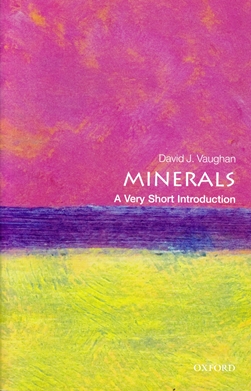 Minerals – a very short introduction
Minerals – a very short introduction
Mineralogy is a vast and complex topic ranging in scope from highly advanced synchrotron radiation research to firing pottery and everything in between; more recently there is a greater focus on the link between minerals and life. To compress this vast deposit of knowledge into a 130 page, pocket sized book is no mean feat.
Vaughan starts off with a brief human history of mineral use and builds into a basic introduction to composition and crystal structures. The tricky topic of symmetry in crystal structure is approached in a simple, logical fashion which makes it easy to understand; essential in an introductory book and executed brilliantly in this concise version.
Certain mineral analysis techniques (such as thin section and scanning electron microscopy) produce beautiful images and those used in this section are well chosen. The author has clearly appreciated the limitations of a book with black & white figures, selecting images that enhance the information within the text, while aesthetically pleasing in themselves.
If you’ve ever wondered why the surface of our planet hosts such a plethora of different rocks and minerals then you’ll need to understand some basic processes of plate tectonics and the structure of the Earth. Vaughan effortlessly covers the structure of our planet with a good mixture of theory, experiment and science history; a theme found throughout the book of explaining how we came to our current understanding. He also brings together concepts introduced earlier to convey more complex ideas.
The section on life and its relationship with minerals hints at what a huge and exciting topic this is. The debate over how life started is looked at here and is a great taster that gives the reader the incentive to investigate the literature further, into an ancient world of black smokers and replicating clays.
With an ever increasing world population, what future do our mineral resources allow us? Do we have enough? Where are they? From nuclear waste cleanup and water purification to smartphones and diamond drills, minerals permeate every part of the modern lifestyle and Vaughan gives a very balanced and interesting discussion of the potential future of mineral exploitation.
A very basic understanding of chemistry, while not essential, would be useful when reading this as it would be impossible to write such a short introduction on minerals without assuming some knowledge of basic chemistry. Overall an excellent choice for those curious to dig deeper into the mineral world.
Reviewed by Jonathan Scafidi
MINERALS: A VERY SHORT INTRODUCTION by DAVID J VAUGHAN, 2014. Published by: Oxford University Press 140pp (pbk) ISBN: 9780199682843 List Price: £7.99. W:
www.oup.com
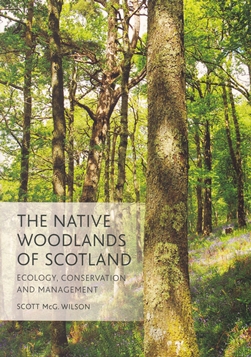 The Native Woodlands of Scotland
The Native Woodlands of Scotland
Not the normal kind of book being reviewed by Geoscientist it has to be said, given the title and subject matter; but we live in an inter-related world where geology impacts what happens on the Earth’s surface in many different ways. One of the most obvious, but often not considered, is how native vegetation depends on soils that are a product of surface geology. To be honest, while discussion on the influence of geology on surface vegetation is included this is not a defining aspect of the book. The book is well written and easy to read.
If you need or want to know how forests in Scotland have evolved since the last Ice Age then the first three chapters are an excellent introduction. As ever, it is fascinating to read how multiple independent strands of research can be pulled together to give a complete oversight of how our world has evolved. The impact of changing climate on vegetation, coupled with the nature of surface soils (so dependent on climate and geology), is well described and the different stages of woodland colonisation of a landscape scraped clean by glaciers is provided. Soil fertility affected by changing climate and the impact on woodlands is a lesson for the future. One cannot ignore human impact either, and it is intriguing how a small population many centuries ago had such a significant impact on woodlands and forests.
To understand the diversity and makeup of different types of woodland in Scotland in current times turn to the middle part of the book for a useful introduction. Descriptions of the history, current distribution, ecology and management regimes are provided for native pinewoods and montane scrub; oak, birch and aspen woodlands; ash, elm and hazel woodlands; and wet woodlands.
The last third of the book discusses current and future potential for woodland in Scotland. The policies and legislation governing silviculture and woodland management is provided in summary – how will this change in the light of Brexit? The final chapters look at different management techniques, discuss how woodland is being reintroduced (‘rewilding’ Scotland) and, finally, where you can visit different woodlands. All in all, a useful book for conservationists working in Scotland.
Reviewed by James Montgomery
THE NATIVE WOODLANDS OF SCOTLAND: ECOLOGY, CONSERVATION AND MANAGEMENT by SCOTT McG WILSON. 2015. Published by: Edinburgh University Press. 271pp (pbk). ISBN 987 0 7486 92859 9. List Price 29.99.
www.euppublishing.com
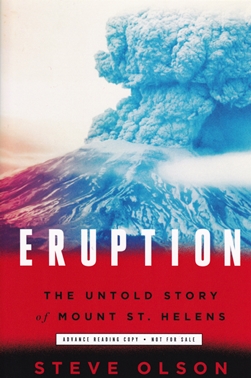 Eruption: The Untold Story of Mount St. Helens
Eruption: The Untold Story of Mount St. Helens
The author combines personal histories with political and cultural assumptions and how they all contribute to the situation prior to and during the eruption and the aftermath. He researched the victims and the personalities involved, which must have involved many hours’ searching family and company histories.
The political scene is set by going back to the 19thC and in particular the origin of the Weyerhaeuser Company (about 40 pages) who ultimately owned much of the land that surrounded the volcano This is followed by a very interesting history of the birth of The Forest Service in the United States, including the complex political ramifications and all its complexities that ultimately led to the Weyerhaeuser Company controlling much of the forest around the volcano and its access in the weeks before the eruption.
The political atmosphere prevails throughout the book where figures such as Dixie Lee Ray, Governor of Washington State and President Jimmy Carter all come in for criticism as the finger of blame is pointed by the relatives of those lost in the eruption. Politics again come to the fore after the eruption, when the formation of The Mount St Helens National Volcanic Monument in 1982 gets approval after much lobbying by conservationists.
The author has conducted an in-depth study of all 57 people who died on the morning of 18 May 1982, including the logger John Killan whose father searched for his body in the ash for years afterwards. Also the young geologist David Johnston who lost his life that morning; although perhaps strangely less is said about the aging character Harry Trueman, who refused to leave his beloved home on the mountain.
This book is a good read, especially if you are interested in US politics and the human story of the victims. The geology is somewhat sparse and patchy, but what is there is, is accurate. It is easy to read and get into the story but is written in a colloquial manner with such phrases as ‘gotten stopped by a state trooper’ and ‘the volcano quieted’, which some may find annoying.
I wish I had read this book before I visited the volcano so that I could appreciate where many of those who perished were when at the time of the eruption. It is a fitting memorial to the USGS geologist David Johnston that the National Volcanic Monument has an interpretive centre named after him. It is well worth a visit.
Reviewed by Richard Porter
ERUPTION: THE UNTOLD STORY OF MOUNT ST HELENS by STEVE OLSON 2015. Published by: W W Norton and Company. New York. ISBN: 9780393242799 £17.99 E:
www.wwnorton.co.uk
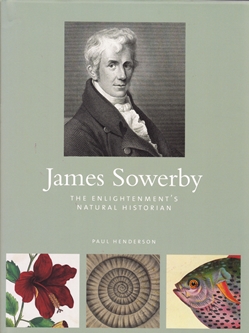 James Sowerby - The Enlightenment’s natural historian
James Sowerby - The Enlightenment’s natural historian
James Sowerby (1757-1822) was the fourth surviving son of a successful lapidary with a business near Fleet Street in London. Showing promise in sketching, he was apprenticed to a painter, Richard Wright, in 1771. Alas! Wright suffered a stroke and died in 1775. An attempt to replace him with William Hodges did not last long, but Hodges had been the official artist on James Cook’s second voyage (1772-1775) which gave James a glimpse of the preparation of engraved illustrations for the book of the expedition.
Notwithstanding his truncated apprenticeship, James by now had enough skill as a painter to sell his work. His lucky break came about 1776. William Curtis, an apothecary turned botanist, was preparing his Flora Londinensis (1777-1798) with 432 hand-coloured engraved plates. Several artists were involved, and it is not clear when Sowerby began to contribute; but when he did, he had mastered the style of drawing, engraving and colouring illustrations of plant specimens. His manifest skill led to numerous requests to supply botanical illustrations.
The Flora was issued in small parts, each with a few plates. Species were illustrated as material became available, so there was no overall plan. Parts had to be collected and bound up at the buyer’s expense. The advantage was that minimal capital investment was needed. All the major works with which Sowerby was involved were published in this way, and it became a speciality of the family business, which he founded.
In February 1786 James married Anne de Carle. His father in law gave the couple a house, 2 Mead Place, Lambeth, which remained James’s home and place of business for the rest of his life. A museum was built at the back about 1796 and the house next door was eventually added.
Sowerby had become a competent botanist and now launched English botany (1790-1814), with 2592 coloured plates, on his own initiative. The enterprise was a success, the later parts, at least, selling about 900 copies.
Towards the end of the century he branched out, publishing British Mineralogy (1802-1817, five volumes) and starting Mineral Conchology (i.e. fossils), 1812-1846, completed by his son James de Carle, as well as other mineralogical and conchological books.
Paul Henderson has given us a comprehensive account of Sowerby’s life and work, with reference to the social and intellectual background of the time. It is lavishly illustrated, chiefly with Sowerby’s own engravings.
Reviewed by Desmond Donovan
JAMES SOWERBY: THE ENLIGHTENMENT’S NATURAL HISTORIAN by PAUL HENDERSON. 2015. Richmond, Royal Botanic Gardens, Kew, 331 pp. ISBN 978 1 84246 596 7 List Price £35.00. W:
www.shop.kew.org/
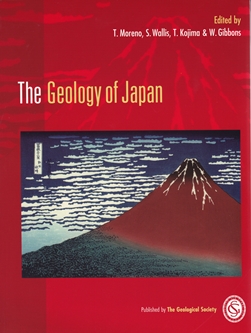 The Geology of Japan
The Geology of Japan
Given the wealth of geological research emanating from the Japanese Islands, it is surprising that this is the first large format English language overview for 25 years of the remarkable insights which have been obtained during this time. Coupled with belts of active volcanism, the whole nation is prone to massive earthquakes, tsunamis, and often rapid rates of erosion and ground deformation which has encouraged further systematic studies, right back to drilling 797 ground investigation boreholes after the 1923 Great Kanto Earthquake that devastated Tokyo and Yokohama. Though most of Japan is divided between the Eurasian and North American plates, it is also impinged upon by the subducting Izu-Ogasawara arc along the northern edge of the Philippine Sea Plate in turn being subducted by the Pacific Plate, which also passes directly under northern Honshu, Hokkaido and the Kuril Arc.
Naturally this requires a curtain-raising overview chapter which like many of the others includes some impressive colour graphics and geophysical maps of the Philippine Sea obtained as part of Japan's preparations for legal claims to continental shelf extending beyond 200 nautical miles. Then a series of chapters details the regional tectonostratigraphy of the islands, including the Palaeozoic basement, accretionary complexes and paired metamorphic belts - before a couple on the two main island arcs. Kyushu-Ryukyu extends over 1000km southwestwards towards Taiwan, while Izu-Bonin stretches from the Izu Peninsula near Tokyo for 2800km to Guam. The first of these does an incredible job illustrating the sheer diversity of earlier rock types thrown together by Cenozoic plate convergence through to ongoing Quaternary volcanism, while the latter reproduces some amazing seismic profiles.
A third of Hokkaido belongs to the Kuril Arc and concludes this section before the more thematic chapters. There are thoroughgoing accounts of the distribution of Ophiolites, Granitic rocks, and Miocene to Holocene volcanism with beautifully crisp black-and-white topographic images and photographs, including several impressive calderas. The deep seismic structure chapter is truly outstanding, including whole-mantle tomography plus numerous other profiles and contoured maps showing depths of both subducting slabs beneath Japan. Then a crustal earthquakes chapter continues this theme, with illustrations of active faults, surface ruptures and 30-year probability zones.
Though coastal geology and oceanography is surprisingly concise, it includes an account of mining-induced subsidence and tsunami deposits: enough to confirm the 1:50,000 geological map covering Fukushima Daiichi, which made no reference to them long before these nuclear reactors were overwhelmed in March 2011. The final chapters outline Mineral and Hydrocarbon resources, engineering geology including landslides, and a guide for potential visitors including parks and museums.
One notable omission is any mention of very limited glaciation, more general environmental conditions and the offshore extent of land during these Quaternary stages. Another is any glossary of common geological terms alongside each chapter, including a guide to Kanji and Hiragana translations for names. Overall, the editors must be congratulated for bringing together the work of over 70 researchers to produce this magnificent volume.
Reviewed by David Nowell
Reference
Geological Survey of Japan 1994. Geology of the Namie and Iwaki-Tomioka district 1:50,000 quadrangle series Niigata (7) No.46 and 47 sheet.
THE GEOLOGY OF JAPAN by T MORENO, S WALLIS, T KOJIMA AND W GIBBONS Published by: Geological Society of London 2016. 522pp ISBN: 978-1-86239-743-9 Pbk: List Price £50, GSL members £37·50 other societies £37·50 Hbk: £100, GSL members £50, other societies £60… W: www.geolsoc.org.uk/bookshop